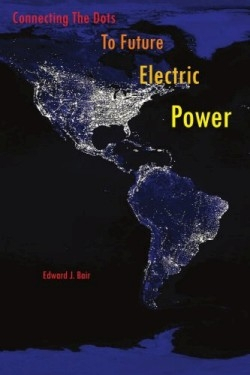It looks like you've stumbled upon a page meant to be read by our code instead of viewed directly. You're probably looking for this page.
Connecting the Dots to Future Electric Power
It may seem far-fetched that by the end of this century a satellite will be furnishing a cheap continuous and inexhaustible supply of electric power to ten billion earthlings. But after reading Ed Bair’s analysis of the current and possible sources of electricity readers will discover that the concept of a solar space station the subject of Bair’s final chapter is anything but whimsical. Bair shows that the “inexorable decline” in the supply and quality of fossil fuels coupled with the supply and efficiency limitations of nuclear hydroelectric geothermal solar and other alternatives will force governments to explore “not the technical feasibility” of the solar space station “but the technical economic and political feasibility of constructing it in orbit.”
Bair’s authority in the realm of electric power is beyond question. A Brown University PhD he has spent much of his career at Indiana University where he is currently an emeritus professor of Chemistry. He is a veteran of the Manhattan Project and has been visiting professor at such places as the National Research Council Cambridge University and the Lawrence Livermore Laboratory. A longtime consultant in the solar power industry Ed Bair is a scientist as well as an engineer/technician. His thesis is clear. His data will be understood best by readers with backgrounds in science and technology.
Bair’s closing pitch for a solar space station is arrived at inductively. He begins by showing—his points throughout the text are supported by extensive documentation and accompanied by charts graphs and tables—that electric power little more than one hundred years old is a “common denominator” in countries where occupational versatility and individual productivity are evident and thus electricity is a basic necessity as well as a benchmark for development. He estimates the amount of power the planet uses and how much it will need before focusing on the sources of power. For each source Bair delves into its origins as well as the cost of supplying it to the power grid its relative pros and cons and its impact on the environment. In his section on nuclear power for instance Bair explains the fission reaction in nuclear material and the heat energy that is generated. He looks at the process of converting uranium to power in nuclear plants arguing that first generation plants are less efficient and must be replaced. But although nuclear power must be utilized to a greater degree than its present 19 of the world’s power supply the supply of uranium—even if used more efficiently—cannot satisfy demand in the long run. Bair shows how the situation of limited and dwindling natural resources impacts each alternative source’s ability to provide enough power at an acceptable cost. But he adds “the one exception to this gloomy outlook is the solar radiant power outside the earth’s atmosphere.”
Reviewed by
Joe Taylor
Disclosure: This article is not an endorsement, but a review. The publisher of this book provided free copies of the book and paid a small fee to have their book reviewed by a professional reviewer. Foreword Reviews and Clarion Reviews make no guarantee that the publisher will receive a positive review. Foreword Magazine, Inc. is disclosing this in accordance with the Federal Trade Commission’s 16 CFR, Part 255.
